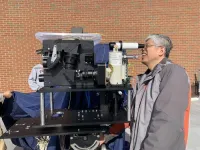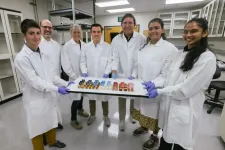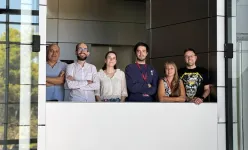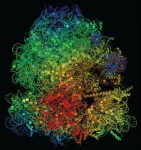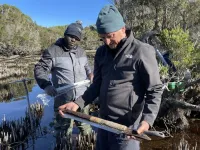(Press-News.org) Fitting in a workout after a long day of sitting at a desk might not be enough to compensate for the impacts of sedentary behavior on the heart. Investigators from Mass General Brigham, found that excessive sedentary behavior (waking activity with low energy expenditure while sitting, reclining, or lying down and not including hours spent sleeping at night) was linked to increased risk of heart disease, especially heart failure and cardiovascular death, and that these risks could be significantly reduced by substituting sedentary time for other activities. They also found that meeting guideline levels of moderate-to-vigorous physical activity may be insufficient on its own to reduce cardiovascular risk if one is also sitting too much. Their results are published in the Journal of the American College of Cardiology.
“Many of us spend the majority of our waking day sitting, and while there's a lot of research supporting the importance of physical activity, we knew relatively little about the potential consequences of sitting too much beyond a vague awareness that it might be harmful,” said lead author Ezimamaka Ajufo, MD, a cardiology fellow at Brigham and Women’s Hospital, a founding member of the Mass General Brigham healthcare system. “Sedentary risk remained even in people who were physically active, which is important because many of us sit a lot and think that if we can get out at the end of the day and do some exercise we can counterbalance it. However, we found it to be more complex than that.”
Ajufo’s team, which included researchers from across Mass General Brigham, analyzed one week of activity-tracker data from 89,530 individuals from the UK Biobank prospective cohort. They looked at associations between daily time spent sitting and the future risk of four common cardiovascular diseases: atrial fibrillation, heart attacks, heart failure, and death from cardiovascular causes. The team used a machine learning algorithm to classify sedentary behavior.
They found sedentary behavior was associated with higher risks of all four types of heart disease, with a marked 40-60 percent greater risk of heart failure and cardiovascular death observed when sedentary behavior exceeded 10.6 hours a day (not including hours spent sleeping). Many of the negative effects of sedentary behavior persisted even among those individuals who achieved the guideline-recommended >150 minutes of moderate-to-vigorous physical activity per week. For example, although the study found that the risk of atrial fibrillation and heart attacks could be mostly eliminated by engaging in physical activity, the excess risk of heart failure and cardiovascular death could only be partially offset by physical activity.
“Our data supports the idea that it is always better to sit less and move more to reduce heart disease risk, and that avoiding excessive sitting is especially important for lowering risk of heart failure and cardiovascular death,” said co-senior author Shaan Khurshid, MD, MPH, an electrophysiologist and faculty member in the Telemachus And Irene Demoulas Family Foundation Center for Cardiac Arrythmias at Massachusetts General Hospital, a founding member of the Mass General Brigham healthcare system.
The research team hopes these findings will help inform future guidelines and public health efforts. They would like future prospective studies to test the efficacy of public health interventions that help people reduce the number of hours they spend being sedentary and see how that affects cardiovascular health. Next, they plan to extend this research to investigate the impacts of sedentary behavior on a range of other diseases and for longer spans of time.
“Exercise is critical, but avoiding excessive sitting appears separately important," said co-senior author Patrick Ellinor, MD, PhD, a cardiologist and co-director of the Corrigan Minehan Heart Center at Massachusetts General Hospital. "Our hope is that this work can empower patients and providers by offering another way to leverage movement behaviors to improve cardiovascular health.”
Authorship: Additional Mass General Brigham authors include Timothy W. Churchill, J. Sawalla Guseh, and Krishna G. Aragam. Additional authors include Shinwan Kany and Joel T. Rämö.
Disclosures: Krishna G. Aragam receives sponsored research support from Sarepta Therapeutics and Bayer AG; he also reports a research collaboration with the Novartis Institutes for Biomedical Research. Patrick T. Ellinor receives sponsored research support from Bayer AG, IBM Research, Bristol Myers Squibb, Pfizer and Novo Nordisk; he has also served on advisory boards and/or consulted for Bayer AG.
Funding: Researchers were supported by the John S. LaDue Memorial Fellowship in Cardiovascular Medicine or Vascular Biology grant, the Walter Benjamin Fellowship from the Deutsche Forschungsgemeinschaft (521832260), a research fellowship from the Sigrid Jusélius Foundation, the National Institutes of Health (K23HL159262-01A1, 1K08HL153937, RO1HL092577, R01HL157635, and K23HL169839-01), the American Heart Association (19AMFDP34990046, 862032, 18SFRN34230127, 961045, and 2023CDA1050571), the President and Fellows of Harvard College (5KL2TR002542-04), and the European Union (MAESTRIA 965286).
Paper cited: Ajufo E, et al. “Accelerometer-Measured Sedentary Behavior and Future Cardiovascular Disease.” Journal of the American College of Cardiology, DOI: 10.1016/j.jacc.2024.10.065
About Mass General Brigham
Mass General Brigham is an integrated academic health care system, uniting great minds to solve the hardest problems in medicine for our communities and the world. Mass General Brigham connects a full continuum of care across a system of academic medical centers, community and specialty hospitals, a health insurance plan, physician networks, community health centers, home care, and long-term care services. Mass General Brigham is a nonprofit organization committed to patient care, research, teaching, and service to the community. In addition, Mass General Brigham is one of the nation’s leading biomedical research organizations with several Harvard Medical School teaching hospitals. For more information, please visit massgeneralbrigham.org.
END
Mass General Brigham researchers find too much sitting hurts the heart
New study shows that being sedentary increases the risk of the most common types of heart disease, even among those who get enough exercise
2024-11-15
ELSE PRESS RELEASES FROM THIS DATE:
New study shows how salmonella tricks gut defenses to cause infection
2024-11-15
A new UC Davis Health study has uncovered how Salmonella bacteria, a major cause of food poisoning, can invade the gut even when protective bacteria are present. The research, published in the Proceedings of the National Academy of Sciences, explains how the pathogen tricks the gut environment to escape the body's natural defenses.
The digestive system is home to trillions of bacteria, many of which produce short-chain fatty acids (SCFAs) that help fight harmful pathogens. But Salmonella manages to grow and spread in the gut, even though ...
Study challenges assumptions about how tuberculosis bacteria grow
2024-11-15
The rod-shaped tuberculosis (TB) bacterium, which the World Health Organization has once again ranked as the top infectious disease killer globally, is the first single-celled organism ever observed to maintain a consistent growth rate throughout its life cycle. These findings, reported by Tufts University School of Medicine researchers on November 15 in the journal Nature Microbiology, overturn core beliefs of bacterial cell biology and hint at why the deadly pathogen so readily outmaneuvers our immune system and antibiotics.
"The ...
NASA Goddard Lidar team receives Center Innovation Award for Advancements
2024-11-15
NASA researchers Guan Yang, Jeff Chen, and their team received the 2024 Innovator of The Year Award at the agency’s Goddard Space Flight Center in Greenbelt, Maryland, for their exemplary work on a lidar system enhanced with artificial intelligence and other technologies.
Like a laser-based version of sonar, lidar and its use in space exploration is not new. But the lidar system Yang and Chen’s team have developed — formally the Concurrent Artificially-intelligent Spectrometry and Adaptive Lidar System (CASALS) — can produce higher resolution data within a smaller space, significantly increasing efficiency compared to current models.
The ...
Can AI improve plant-based meats?
2024-11-15
Cutting back on animal protein in our diets can save on resources and greenhouse gas emissions. But convincing meat-loving consumers to switch up their menu is a challenge. Looking at this problem from a mechanical engineering angle, Stanford engineers are pioneering a new approach to food texture testing that could pave the way for faux filets that fool even committed carnivores.
In a new paper in Science of Food, the team demonstrated that a combination of mechanical testing and machine learning can describe food texture with striking similarity to human taste testers. Such a method could speed up the development of new and better plant-based meats. The team also found that ...
How microbes create the most toxic form of mercury
2024-11-15
Mercury is extraordinarily toxic, but it becomes especially dangerous when transformed into methylmercury – a form so harmful that just a few billionths of a gram can cause severe and lasting neurological damage to a developing fetus. Unfortunately, methylmercury often makes its way into our bodies through seafood – but once it’s in our food and the environment, there’s no easy way to get rid of it.
Now, leveraging high-energy X-rays at the Stanford Synchrotron Radiation Lightsource (SSRL) at the U.S. Department of Energy’s SLAC National Accelerator Laboratory, ...
‘Walk this Way’: FSU researchers’ model explains how ants create trails to multiple food sources
2024-11-15
It’s a common sight — ants marching in an orderly line over and around obstacles from their nest to a food source, guided by scent trails left by scouts marking the find. But what happens when those scouts find a comestible motherlode?
A team of Florida State University researchers led by Assistant Professor of Mathematics Bhargav Karamched has discovered that in a foraging ant’s search for food, it will leave pheromone trails connecting its colony to multiple food sources when they’re available, ...
A new CNIC study describes a mechanism whereby cells respond to mechanical signals from their surroundings
2024-11-15
To the casual eye, a memory foam mattress would appear to have no relationship to the behavior of cells and tissues. But an innovative study carried out at the Centro de Investigaciones Cardiovasculares (CNIC) in Madrid shows that viscoelasticity—the capacity of a material to be compressed and then recover its original form, like memory foam—is a little-explored property of biological tissues that is essential for correct cell function.
Study leader Dr. Jorge Alegre-Cebollada, who heads the Molecular Mechanics of the Cardiovascular System laboratory at the CNIC, explained that proper cell function requires ...
Study uncovers earliest evidence of humans using fire to shape the landscape of Tasmania
2024-11-15
Some of the first human beings to arrive in Tasmania, over 41,000 years ago, used fire to shape and manage the landscape, about 2,000 years earlier than previously thought.
A team of researchers from the UK and Australia analysed charcoal and pollen contained in ancient mud to determine how Aboriginal Tasmanians shaped their surroundings. This is the earliest record of humans using fire to shape the Tasmanian environment.
Early human migrations from Africa to the southern part of the globe were well underway during the early part of the last ice age – humans reached northern ...
Researchers uncover Achilles heel of antibiotic-resistant bacteria
2024-11-15
Recent estimates indicate that deadly antibiotic-resistant infections will rapidly escalate over the next quarter century. More than 1 million people died from drug-resistant infections each year from 1990 to 2021, a recent study reported, with new projections surging to nearly 2 million deaths each year by 2050.
In an effort to counteract this public health crisis, scientists are looking for new solutions inside the intricate mechanics of bacterial infection. A study led by researchers at the University of California San Diego has discovered a vulnerability within strains of bacteria that are antibiotic resistant.
Working with labs at Arizona State University and the Universitat ...
Scientists uncover earliest evidence of fire use to manage Tasmanian landscape
2024-11-15
Some of the first humans to arrive in Tasmania, over 41,000 years ago, used fire to shape and manage the landscape, a new study from The Australian National University (ANU) and the University of Cambridge has found.
It is thought to be the earliest and most detailed record of humans using fire in the Tasmanian environment.
According to the researchers, early inhabitants of Tasmania were managing forests and grasslands by burning them to create open spaces, possibly for food procurement and cultural activities.
The team analysed traces of charcoal and pollen contained in ancient mud that showed how Indigenous Tasmanians (Palawa) ...
LAST 30 PRESS RELEASES:
Global study reveals widespread burning of plastic for heating and cooking
MIT study shows pills that communicate from the stomach could improve medication adherence
Searching for the centromere: diversity in pathways key for cell division
Behind nature’s blueprints
Researchers search for why some people’s gut microbes produce high alcohol levels
Researchers find promising new way to boost the immune response to cancer
Coffee as a staining agent substitute in electron microscopy
Revealing the diversity of olfactory receptors in hagfish and its implications for early vertebrate evolution
Development of an ultrasonic sensor capable of cuffless, non-invasive blood pressure measurement
Longer treatment with medications for opioid use disorder is associated with greater probability of survival
Strategy over morality can help conservation campaigns reduce ivory demand, research shows
Rising temperatures reshape microbial carbon cycling during animal carcass decomposition in water
Achieving ultra-low-power explosive jumps via locust bio-hybrid muscle actuators
Plant-derived phenolic acids revive the power of tetracycline against drug-resistant bacteria
Cooperation: A costly affair in bacterial social behaviour?
Viruses in wastewater: Silent drivers of pollution removal and antibiotic resistance
Sub-iethal water disinfection may accelerate the spread of antibiotic resistance
Three in four new Australian moms struggle with body image
Post-stroke injection protects the brain in preclinical study
Cardiovascular risk score predicts multiple eye diseases
Health: estimated one in ten British adults used or interested in GLP-1 medications for weight loss
Exercise to treat depression yields similar results to therapy
Whooping cough vaccination for pregnant women strengthens babies’ immune system
Dramatic decline in new cases of orphanhood in Uganda driven by HIV treatment and prevention programs
Stopping weight loss drugs linked to weight regain and reversal of heart health markers
Higher intake of food preservatives linked to increased cancer risk
Mass General Brigham–developed cholera vaccine completes phase 1 trial
First experimental validation of a “150-year-old chemical common sense” direct visualization of the molecular structural changes in the ultrafast anthracene [4+4] photocycloaddition reaction
Lack of support for people on weight loss drugs leaves them vulnerable to nutritional deficiencies, say experts
Dogs’ dinners can have greater climate impact than owners’
[Press-News.org] Mass General Brigham researchers find too much sitting hurts the heartNew study shows that being sedentary increases the risk of the most common types of heart disease, even among those who get enough exercise
